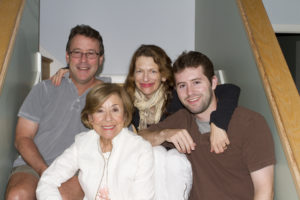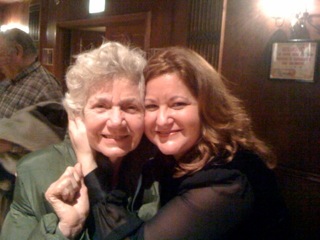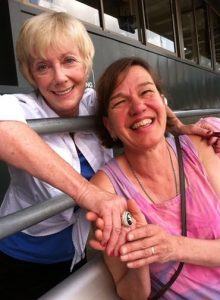Benefits of Teaching Memoir: It Can Be Good for a Laugh
November 7, 2018 • 3 Comments • Posted in careers/jobs for people who are blind, guest blog, memoir writing, teaching memoir, writing promptsAll five of the weekly memoir-writing classes I lead in Chicago are back in full swing now, and Michael Graff, a writer in one of the Village Chicago classes I lead, generously agreed to let us share a deadpan “Back to School” essay he read out loud Monday for the first meeting of the current six-week session. Enjoy!
by Michael Graff

That’s Michael (left), Nancy and their son Evan, with Michael’s mother (Delores) in the foreground.
When Nancy worked at the First National Bank of Chicago, she planned either to apply to Law School or an MBA program. I was building my business. We decided we’d both take accounting, at night, at DePaul University’s downtown Chicago campus. It was just for fun. Back then free parking could always be found after six on Michigan Avenue or Wabash. Each Monday, after work, we met at class and afterward we’d celebrate with a late dinner at the Chicago Claim Company’s twin restaurant Jasand’s, on Rush.
In high school Nancy was a National Merit Scholar, Phi Beta Kappa in college, and she always graduated with honors. Me, I just graduated. I never worked too hard at school. My grades conveyed that fact. Our DePaul credits weren’t for any degree. I planned to simply coast through it.
At DePaul many of our fellow students, unlike us, couldn’t afford college after high school. They were hard working part time students who juggled careers and family; DePaul was their future.
The mid-term rolled along and Nancy aced it. I got a C+ or B-. I don’t recall, nor care.
But Nancy cared.
“You’re going to study harder,” she said. I was dismissive, but Nancy was serious. The weekend before our final exam I was confined to quarters. Nancy took away every diversion while I stared at debits and credits or solved balance sheet riddles. When I could stand no more, I’d wander towards the TV, but Nancy had thought of that. The remote was gone.
“I need to watch the Bears game,” I told her.
“Back to work, you’re not even a Bears fan”.
I was that weekend!
To my great relief, the final was the next day. Finally I was out of accounting purgatory. About ten days later, I returned to our apartment. On our dining room table sat an unopened envelope addressed to me from DePaul. Next to it, on display, was Nancy’s grade.
She’d gotten an A.
“Why didn’t you open mine,” I asked?
“I thought maybe you’d want to do that in private,” she said.
“Oh, I don’t care,” I said with a shrug, tearing open the envelope. After glancing at my grade, I folded the paper and set it down.
”What did you get?”
“It’s not important.”
“What?”
“I got a C.”
“That’s not fair. You should have gotten a better grade. Complain to our teacher.”
“Don’t be ridiculous.”
“But you deserved better.”
“Maybe I don’t.”
Finally, I said, “Okay, it’s a B.” Nancy smiled, “that’s good. You deserve a B.”
And that’s when I unfolded my grade and held it up to her. Her eyes widened, and then she frowned. “Well,” she shrugged. “I guess he’ll hand out an A to anyone.”
We enjoyed accounting class. We signed up for accounting 105, and after that, cost accounting. I continued to do OK.



